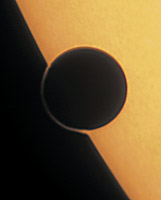
Venus Transit on the Sun
by Lorenzo Comolli
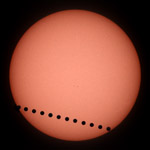
 |
Venus Transit on the Sun by Lorenzo Comolli |
 |
Here in Tradate (VA), the transit started at local 5.21 (UT, h 15°) and ended at 11.23 (h 67°), and tested our resistance under high temperatures!
The ingress showed clearly the RING OF LIGHT, the phenomena due to the atmosphere of Venus that refract the light of the Sun. At 5.29 I saw a little piece of the ring in the southern part of Venus, that increased continuously, then at 5.32 also the northern part of the ring started to be visible, and finally at 5.34 the ring was complete!!! Then the ring increasend in brightness and was easily visible at 5.39, a minute before the whole disk was over the Sun (5.40). Because the seeing was quite good, I've not seen the BLACK DROP. The entrance of the disk was very sharp.
The egress instead was observed under worse seeing conditions even if the Sun was really high in the sky. At 11.04 the BLACK DROP was evident, expecially in the worse seeing moments. The RING OF LIGHT was visible at 11.05 but was less bright than during the ingress, maybe due to the turbolence of the air. At 11.08 the ring started to separate in two pieces and the southern part was clearly brighter. At 11.11 the northern part gradually disappeared and the southern part was reduced in visibility. Finally at 11.18 also the southern part disappeared. The complete egress of Venus was at 11.23.
Overall it was really a great show and the ring of light was a greatly appreciated price for 8 hours under the Sun.
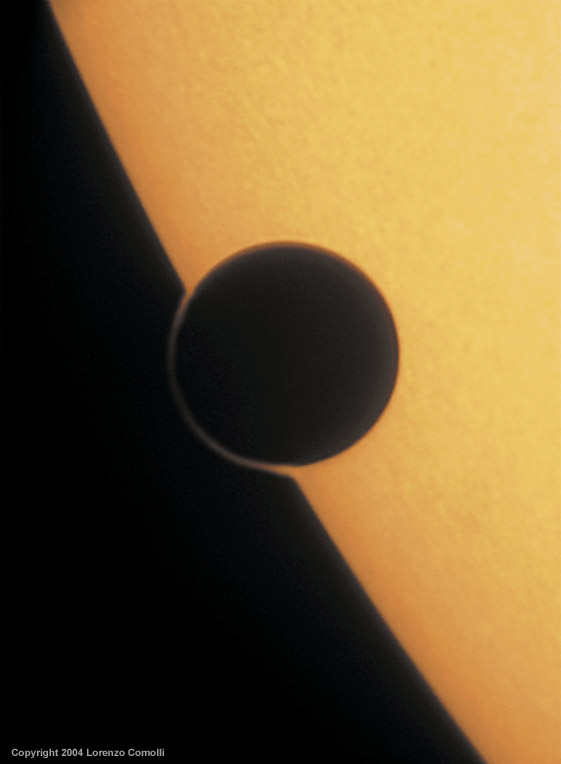 |
INGRESS: the ring of light
The interesting phase is the ingress and egress of the disk, many are the phenomena to study in this moments: the ring of light (see image) and the black drop. This phase lasted about 20 minutes! Mean of about 250 frame. Unsharp mask. Imaged with a Schmidt-Cassegrain 20cm, a Panasonic NV-DS15 digital camcorder at afocal focus of a 40mm eyepiece, time of the image 5.34 UT, location Tradate (VA), near Milan, Italy. Compositation from correctly exposed and overexposed films of 10s each, with Iris and Photoshop. |
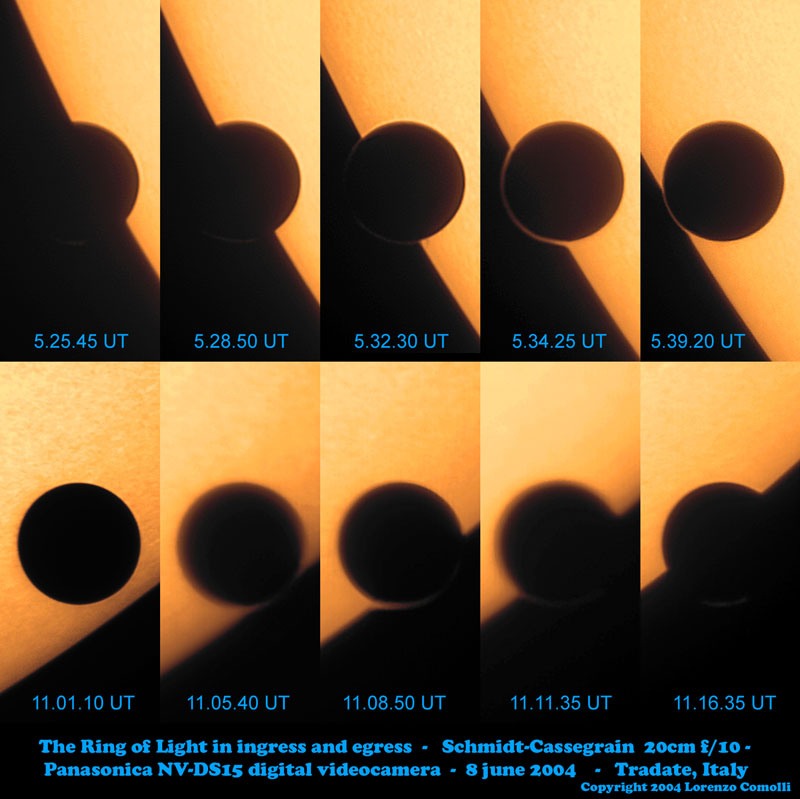
EVOLUTION of the Ring of Light A series of images of the ring of light, caused by the atmosphere of Venus that refract the solar light. Note the Southern polar cap that is brighter: this because the lower temperature of the atmosphere causes a bigger refractive index. Each frame is the mean of about 250-350 frames. Schmidt-Cassegrain 20cm telescope, Panasonic NV-DS15 videocamera, in afocal projection from a 40mm eyepiece. Compositation from correctly exposed and overexposed films of 10s each, with Iris and Photoshop. |
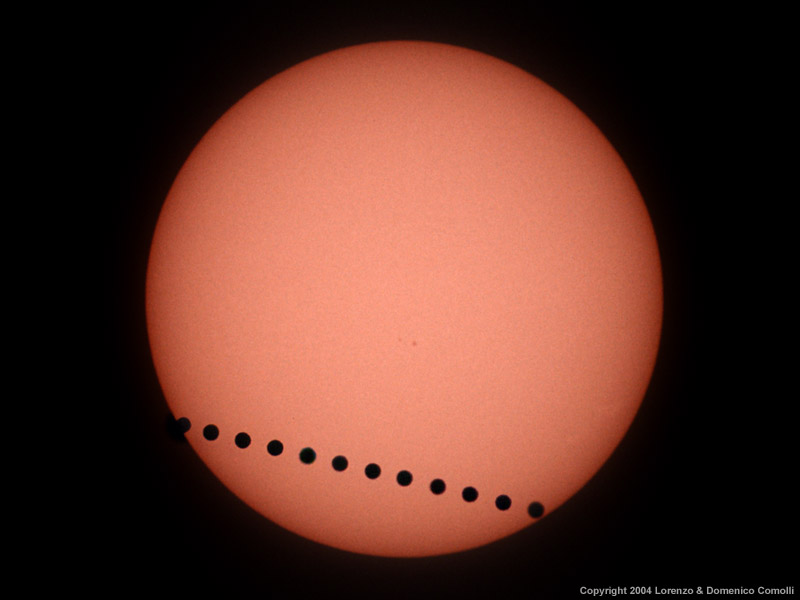
The transit SEQUENCE Sequence of the whole event with full size Sun, each frame imaged at 30 minutes intervals, from 5.30UT to 11.00 UT. Composition of 12 frames imaged with a Pentax 75 apo refractor (500mm focal lenght + focal duplicator) un Kodak Elite 100 ISO film. Exposure times from 1/250s with Astrosolar d=3 solar filter to 1/30s with a glass d=5 solar filter. |
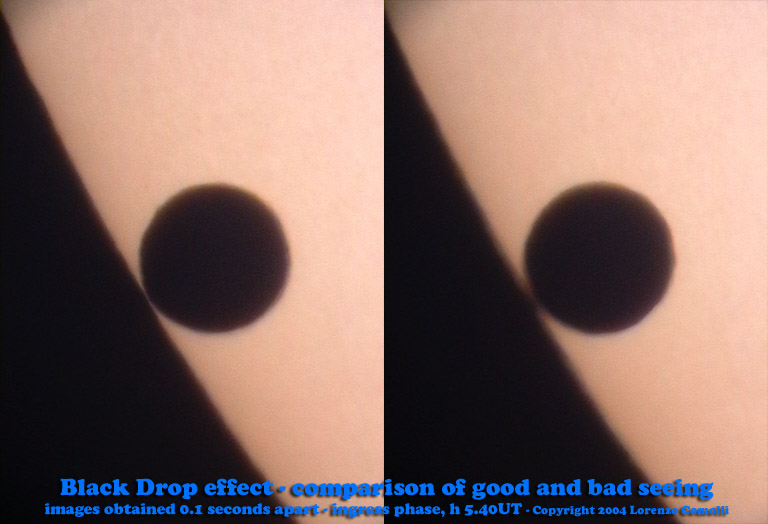
INGRESS: the blackdrop The phenomena of the "blackdrop" was nearly inappreciable in the ingress phase, here is a comparison between single frames obtained with good and bad seeing. Single frames, no elaboration. Imaged with a Schmidt-Cassegrain 20cm, a Panasonic NV-DS15 digital camcorder at afocal focus of a 40mm eyepiece, time of the image 5.34 UT, location Tradate (VA), near Milan, Italy. |
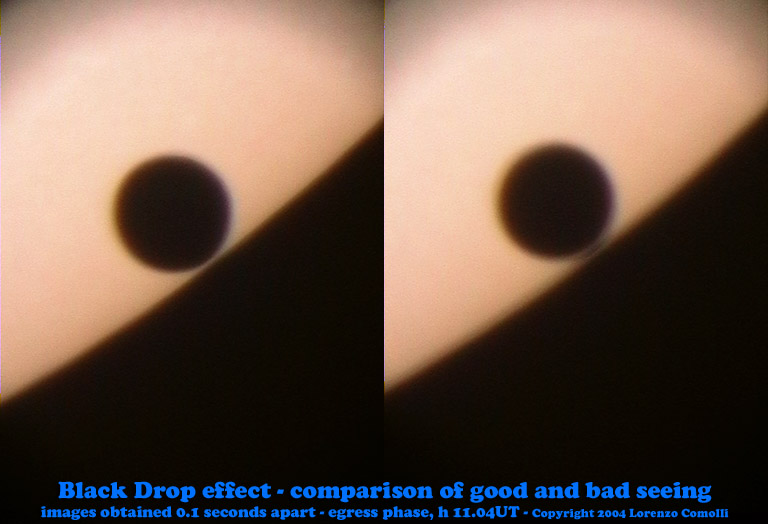
EGRESS: the blackdrop During the egress phase the seeing was worse, a lot of frames showed the blackdrop. Here is a comparison between single frames obtained with good and bad seeing. Single frames, no elaboration. Imaged with a Schmidt-Cassegrain 20cm, a Panasonic NV-DS15 digital camcorder at afocal focus of a 40mm eyepiece, time of the image 11.04 UT, location Tradate (VA), near Milan, Italy. |

EGRESS: the blackdrop Here is a comparison between single frames obtained with good and bad seeing. Single frames, no elaboration. Imaged with a Schmidt-Cassegrain 20cm, a Panasonic NV-DS15 digital camcorder at afocal focus of a 40mm eyepiece, time of the image 11.04 UT, location Tradate (VA), near Milan, Italy. |
 |
INSTRUMENTS
The telescope used for the imaging of the transit, a SC20cm with afocal projection on a digital camcorder. All under thin film of aluminium for rejecting the heat. |
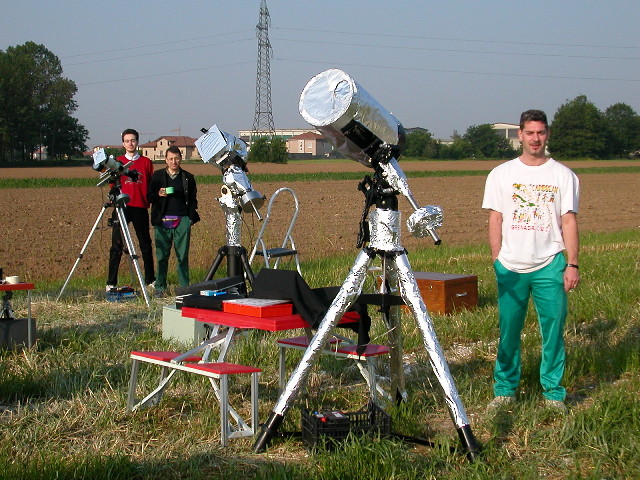 |
THE OBSERVING FIELD
In the observing field was present also (from left) Alessandro, my father (photos on Pentax75) and Stefano (webcam on C11). |
For every comment: comolli@libero.it
|
|